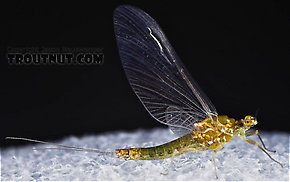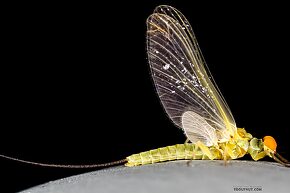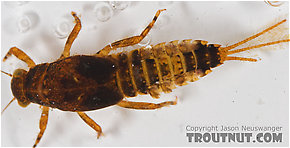Blog & Latest Updates
Fly Fishing Articles
Insects by Common Name


Mayfly Species Ephemerella excrucians (Pale Morning Dun)
Taxonomic Navigation -?-
Kingdom
Animalia (Animals)
» Phylum
Arthropoda (Arthropods)
» Class
Insecta (Insects)
» Order
Ephemeroptera (Mayflies)
» Species excrucians (Pale Morning Dun)
Common Names
Ephemerella excrucians or Pale Morning Dun usually follows its larger sibling Ephemerella dorothea infrequens with which it shares the same common name. What it often lacks in size by comparison is made up for with it's duration, often lasting for months with intermittent peaks. This close relationship with infrequens has led many anglers to confuse Pale Morning Dun biology with that of the multivoltine (Multivoltine: Having more than one generation per year.) Baetidae species, having disparate broods that decrease in size as the season advances. Sharing the same common name has not helped to alleviate this misconception.
Until recently, Ephemerella excrucians was considered primarily an upper MidWestern species of some regional importance commonly called Little Red Quill among other names. Recent work by entomologists determined that it is actually the same species as the important Western Pale Morning Dun (prev.Ephemerella inermis), and the lake dwelling Sulphur Dun of the Yellowstone area, (prev.Ephemerella lacustris). Since all three are considered variations of the same species, they have been combined into excrucians, being the original name for the type species reported as far back as the Civil War. Angler speculation had simmered for some time that the stillwater loving Ephemerella lacustris was much more widespread, inhabiting more water types then previously thought and could account for many large sulfurish ephemerellids found in still to very slow water locations throughout the West. With the revisions, this discussion is now moot.
Ephemerella excrucians variability in appearance, habitat preferences, and wide geographical distribution are cause for angler confusion with the changes in classification. They can be pale yellow 18's on a large Oregon river, creamy orange 14's on western lakes and feeder streams, large olive green on CA spring creeks as well as tiny sulfur ones in many Western watersheds. Then there's the little Red Quill on small streams in Wisconsin. Yet, all are the same species.
Where & When
Regions: East, Midwest, West
Time Of Year (?): April through October with peaks of a month or more within this period depending on location
Preferred Waters: All water types except warm river systems and infertile high country lakes
Altitude: variable
These ubiquitous mayflies are extremely abundant throughout the West and have a wide range of dates for their emergence. There is considerable evidence that on temperature stable spring creeks they can have asynchronous (Asynchronous: The same generation hatching at different times.) emergences in the spring and fall, not to be confused with many baetids multivoltine (Multivoltine: Having more than one generation per year.) life history (Life history: The detailed life cycle of an organism, including the stages it passes through and characteristic behavior relating to growth and reproduction.). In contrast, Eastern emergences are shorter, smaller and far less significant. Anglers would be wise to consult hatch charts and obtain current local information on specific rivers to time this species. Keep in mind that these charts usually combine them with the often larger and earlier hatching Ephemerella dorothea infrequens as they are very difficult to tell apart.Time Of Year (?): April through October with peaks of a month or more within this period depending on location
Preferred Waters: All water types except warm river systems and infertile high country lakes
Altitude: variable
Hatching Behavior
Time Of Day (?): Late morning and early evening in the West; late afternoon to evening in the East
Habitat: Highly variable, though the greatest concentrations occur in weedy riffles and runs
Water Temperature: Varies with location
As noted with Ephemerella dorothea infrequens, excrucians is a classic surface emerger and often engage in "practice runs" exposing the nymphs to trout during extended pre-hatch periods. The main differences are that their smaller size means they struggle a bit more with the water's surface tension and the warmer weather they usually hatch in also means they spend less time on the water preparing their wings for flight. As a result, the observant angler should look for this and be even more ready to use emerger and cripple (Cripple: In fly fishing, a cripple is any insect which has been injured or deformed so that it cannot escape the water. This may include stillborn emergers or fully emerged adults which have been damaged, often by wind or waves, so that they can no longer fly. Trout often favor eating crippled insects.) patterns if high floating dun imitations prove unproductive. Because of this hatches duration and sheer numbers, the fish become increasingly wary as the season progresses. Towards the end of their cycle on heavily fished water, even the most expert angler will be challenged to the limit. Fishing the 'right" fly is usually eclipsed by the need to avoid micro drag and pickup/deliveries that alert the quarry to the attempted fraud.Habitat: Highly variable, though the greatest concentrations occur in weedy riffles and runs
Water Temperature: Varies with location
Spinner Behavior
Time Of Day: Morning and again at dusk in the West; only dusk in the East, where they're not important
Habitat: See notes
The spinner falls are insignificant in some locations while achieving legendary status in others. They can be so dense at times that they are virtually unfishable. They prefer riffles if they exist. Otherwise they seem to pick specific areas for a variety reasons, most often riparian shelter, depth, and substrate related. See comments on Ephemerella dorothea infrequens hatch page for additional information.Habitat: See notes
Nymph Biology
Diet: Detritus (Detritus: Small, loose pieces of decaying organic matter underwater.) and algae
Current Speed: Slow to fast in the West; medium to fast in the East
Substrate: All types, but prefer gravel and cobble with weed growth or the edges of weed beds in spring creeks
The nymphs can be important to imitate before and during the emergence. They come in shades of olive or very dark brown, but they also run the gamut of cinnamons like the larger infrequens. Unlike their big sisters though, excrucians nymphs are often patterned with longitudinal stripes and/or a veriagated pattern on the abdominal dorsum. Trout can be selective to these schemes.Current Speed: Slow to fast in the West; medium to fast in the East
Substrate: All types, but prefer gravel and cobble with weed growth or the edges of weed beds in spring creeks
Pictures of 22 Mayfly Specimens in the Species Ephemerella excrucians:
Female Ephemerella excrucians (Pale Morning Dun) Mayfly Spinner View 11 Pictures
View 11 Pictures
 View 11 Pictures
View 11 PicturesCollected July 1, 2005 from the Bois Brule River in Wisconsin
Added to Troutnut.com by Troutnut on April 22, 2006
Added to Troutnut.com by Troutnut on April 22, 2006
Male Ephemerella excrucians (Pale Morning Dun) Mayfly Dun View 7 Pictures
View 7 Pictures
 View 7 Pictures
View 7 PicturesCollected July 31, 2020 from the Henry's Fork of the Snake River in Idaho
Added to Troutnut.com by Troutnut on August 17, 2020
Added to Troutnut.com by Troutnut on August 17, 2020
Ephemerella excrucians (Pale Morning Dun) Mayfly Nymph View 5 PicturesI spent (Spent: The wing position of many aquatic insects when they fall on the water after mating. The wings of both sides lay flat on the water. The word may be used to describe insects with their wings in that position, as well as the position itself.) a while with a microscope to fairly positively identify this specimen as Ephemerella excrucians.
View 5 PicturesI spent (Spent: The wing position of many aquatic insects when they fall on the water after mating. The wings of both sides lay flat on the water. The word may be used to describe insects with their wings in that position, as well as the position itself.) a while with a microscope to fairly positively identify this specimen as Ephemerella excrucians.
 View 5 PicturesI spent (Spent: The wing position of many aquatic insects when they fall on the water after mating. The wings of both sides lay flat on the water. The word may be used to describe insects with their wings in that position, as well as the position itself.) a while with a microscope to fairly positively identify this specimen as Ephemerella excrucians.
View 5 PicturesI spent (Spent: The wing position of many aquatic insects when they fall on the water after mating. The wings of both sides lay flat on the water. The word may be used to describe insects with their wings in that position, as well as the position itself.) a while with a microscope to fairly positively identify this specimen as Ephemerella excrucians.Collected June 9, 2005 from the Bois Brule River in Wisconsin
Added to Troutnut.com by Troutnut on May 26, 2006
Added to Troutnut.com by Troutnut on May 26, 2006
Recent Discussions of Ephemerella excrucians
PMD Spinner - Egg sack color? 20 Replies »
Do any of you entomologist types know the true color of the PMD spinner? Dorothea or excrucians. Where I fish in MT there are huge spinner falls, many spents are on the water in the morning and others fall again at various periods during the day. I'd like to tie some with egg sacks as I saw many in July but forgot what color they were. Thanks.
ReplyYour Thoughts On Ephemerella excrucians:
Top 10 Fly Hatches
Top Gift Shop Designs
Eat mayflies.
Top Insect Specimens
Miscellaneous Sites
Troutnut.com is copyright © 2004-2024 Jason
Neuswanger (email Jason). See my FAQ for information about use of my images.
 privacy policy
privacy policy
